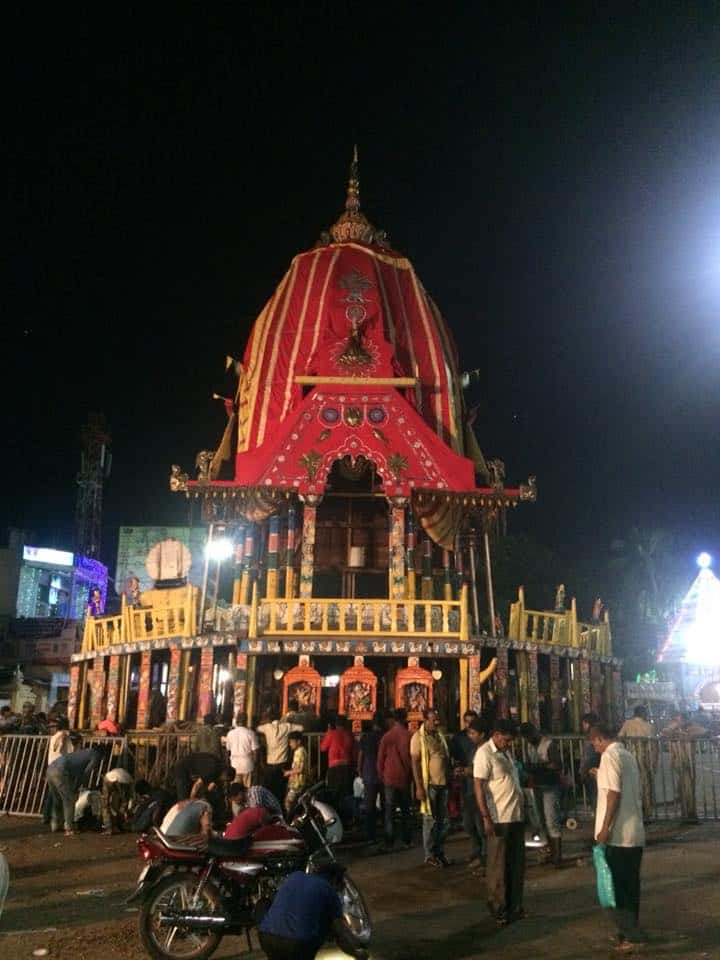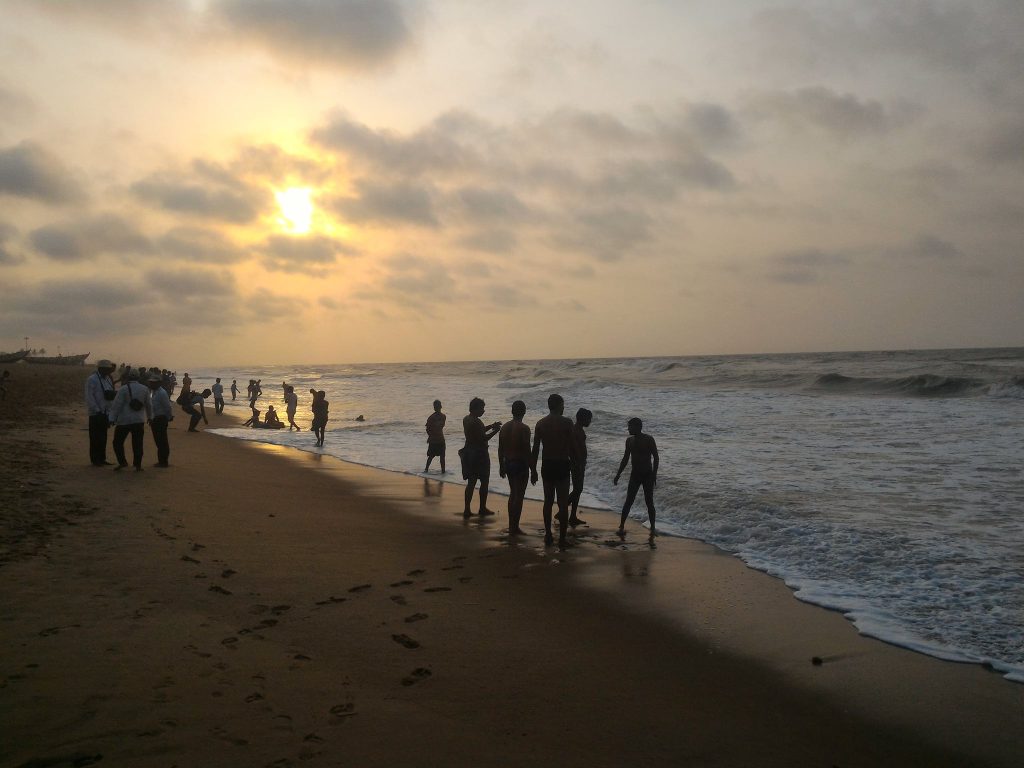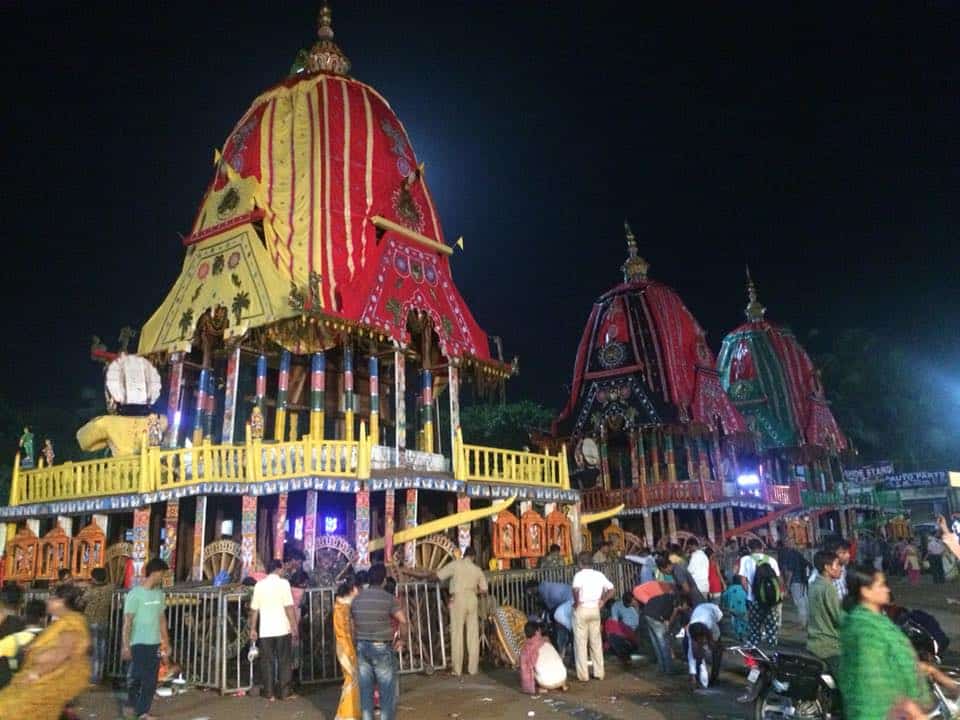The sky was a flat monsoon grey and vestiges of last night’s rain were still visible in the fresh puddles in the lawn. From my hotel window, at early dawn, the holy city of Puri seemed mystical, the skyline a little blurry in the rain-triggered mist.
In the distance, the temple of Lord Jagannath spiraled up towards the sky, as if guarding the city itself. Standing on a promontory, surrounded by lush green coconut palms, the Srimandira, the temple abode of Lord Jagannath, is one of the finest specimens of the Kalinga style of architecture. Soaring 200 feet from the ground, it dominates the skyline of the city.
This ancient town on the east coast of India has attracted the pious and the devout for millennia. The Mahabharata narrates how the Pandava brothers offered prayers on the sacred platform here.
Puri – The Festivals of Chariots
During the British era, it became a hub for travelers seeking leisure. And once the railway tracks were extended to Puri, tourists, both Indians and Europeans, started arriving here in hordes.
The iconic beach-front BNR Hotel, run by the erstwhile Bengal Nagpur Railway company, was a favorite haunt of affluent visitors. Its sprawling campus, spacious rooms and wide balconies overlooking the sea were as legendary as its liveried bearers and gourmet spreads.
While Puri is an all-season destination, it attracts hundreds during the monsoon months, when the famous Ratha Yatra festival takes place. Besides 12 major annual festivals, more than a 100 others are celebrated in the temple town.
But the most colorful, elaborate and attractive among them is the Ratha Yatra, the Festival of Chariots. This annual festival is celebrated on the second day of the bright fortnight of Asadha, the first month of the Indian monsoon.
It is a fortnight-long event, during which the idols of Lord Jagannath and his siblings, Lord Balabhadra and Goddess Subhadra, are taken out of the temple sanctum and transported to the Gundicha temple, considered to be Lord Jagannath’s garden house and birthplace, in elaborately decorated chariots.
Three huge wooden chariots are constructed every year for this ritual sojourn. Covered with colorful canopies, these are decorated with paintings, small statuettes, carvings, brass engravings and a profusion of garlands.
The deities are taken to the chariots in a regal procession with much pomp and joy. Servitors carry three circular ceremonial umbrellas, one for each sibling, and large fans with applique work fixed to long poles, while others fan the deities with similar small hand fans and fly whisks, As the deities are carried forward, the air reverberates with trumpet calls, the clashing of cymbals and beating of drums.
Dancers and acrobats perform, as loud chanting by a sea of devotees fills the air. Decorated with large heart-shaped floral crowns called Tahia, the deities are taken to their chariots in a slow step-by-step movement known as Pahandi. After they are placed in their respective chariots, the Gajapati king of Puri offers prayers, and sweeps and cleans each chariot in a ceremony known as Chhera Pahanra.
Finally, the chariots are pulled by devotees along Puri’s grand avenue or Bada Danda. The chariots cover a distance of three kilometers to the Gundicha temple, the journey taking almost half a day, as hundreds of thousands jostle for a chance to pull the chariots and offer prayers.
After a week, the deities ride their chariots back in a journey known as Bahuda Yatra. On the way back, Lord Jagannath is ceremonially offered Poda Pitha, a traditional dessert, by Goddess Ardhasini, popularly believed to be his aunt.
On the day following the Bahuda Yatra, the deities gove audience in the Suna Vesha or golden appearance on their chariots, a glittering spectacle witnessed by millions. The next day, in the Adhara Pana ritual, a sweet drink, or Panna, is offered to them in large cylindrical pots.
Finally, the deities return to the sanctum in the last ceremony known as Niladri Bije. On this day, Lord Jagannath ceremonially offers another traditional dessert, Rasagola to Goddess Mahalaksmi, his celestial spouse.
Rasagola, also known as Rosogolla in neighboring state West Bengal, a succulent sweet made of fresh cottage cheese, is one of Puri’s must-have delicacies. One should also try the temple food or magaprasada, a true cornucopia of vegetarian delicacies from the state. Puri is also a hub of sweet treats such a gaja, khaja, poda pitha and malpua.
The monsoon months also mark the Jhulana Yatra festival, typically held in early August. The festival is celebrated in an elaborate way in the Mathas or monasteries around the temple. During this festival, idols of Radha and Krishna are placed on a ceremonial swing.
The large swings, decorated with colorful paper designs, white cork flowers, and Papier Mache masks, are gently pulled by devotees, celebrating the eternal love play of the divine couple. Many of these Mathas also organize Gotipua dance performances. In this dance form, which is a variant of Odissi, young boys-often dressed as girls-present bandha Nrutya, displaying acrobatic postures following the beat of traditional Odissi songs.

How to Reach Puri
By Air: the nearest airport is in the city of Bhubaneswar which is 60 km from Puri
By Rail: Puri has direct express and superfast trains from all major cities including Delhi (5), Mumbai (3), Kolkata (7), Bengaluru (1) etc.
By Road: The bus stand near the temple provides frequent connections to Bhubaneswar and Cuttack which are connected to all nearby towns and cities.
Common Itinerary from Delhi
Day 1: Arrive in Bhubaneswar by flight or train. A day at leisure but optionally, one can visit the famous Nandankanan zoo.
Day 2: On the way to Puri from Bhubaneswar, visit Konark Sun temple which is a World Heritage Monument and Chandrabhaga beach. Evening visit to Jagannath temple darshan, arti & pooja. Overnight stay at Puri. One can also visit Dhauli, Pipli and Raghurajpur villages en route.
Day 3: Early morning Jagannath temple visit followed by a drive to Chilika lake for boating and picnic. Reach Bhubaneswar by evening directly and proceed to airport/ railway station for the return journey to Delhi
Where to Eat & Stay in Puri
In Puri, one can either stay near the beach or the temple but not both. However, either would be a 15-20 mins walk, or a shorter ride using a local rickshaw. Puri has heritage hotels such as the Mayfair or the Mahodadhi Palace or the BNR hotel as well as humble homestays facing the sea. Even the Orissa tourism hotels in Puri are highly rated. So, all in all, there are many hotels in Puri to suit the needs of all budgets.
Being close to the sea, one gets excellent seafood in Puri. A spiced fish thali can fetch the real taste of Orissa in an instant. Chakra Tirtha Road houses some of the best backpacker cafes in Puri while the joints on VIP road are more formal and fit for family groups. Marine drive, parallel to the beach, has a long esplanade and is also popular among tourists who prefer slightly upmarket dining options.
Having said that, one must try Jagannath temple’s mahaprasada, a spread of vegetarian dishes served at the temple and the local sweet delicacies sold nearby including the famous rosogulla and malpua.
Other tips when traveling to Puri
Puri experiences severely high temperature during summer months. It is recommended to keep sunglasses and sunscreen lotion handy. Non-Hindus are not allowed to enter the Jagannath temple but can visit the outer sanctum. The beaches are not very well lit and should be avoided after sunset. If you’re planning to visit Puri during the Rath Yatra, it is best to book hotels in Puri in advance. Thousands of devotees flock the city during that time, and the prices of hotels shoot up. Also, the hotel rooms fill up pretty fast.

Conclusion
I hope the article helps you in traveling to Puri and gives you an understanding of this holy city. If you happen to have any questions, feel free to post them in the comments section of the article.
I know this is a bit off topic but I felt sharing it with all of you as I liked the place a lot when visiting it.






